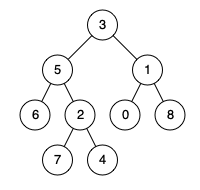【剑指Offer-68-II】二叉树的最近公共祖先
问题
给定一个二叉树, 找到该树中两个指定节点的最近公共祖先。
最近公共祖先的定义为:“对于有根树 T 的两个结点 p、q,最近公共祖先表示为一个结点 x,满足 x 是 p、q 的祖先且 x 的深度尽可能大(一个节点也可以是它自己的祖先)。”
例如,给定如下二叉树: root = [3,5,1,6,2,0,8,null,null,7,4]

示例
输入: root = [3,5,1,6,2,0,8,null,null,7,4], p = 5, q = 1
输出: 3
解释: 节点 5 和节点 1 的最近公共祖先是节点 3。
解答1:求出路径(回溯)
class Solution {
public:
TreeNode* lowestCommonAncestor(TreeNode* root, TreeNode* p, TreeNode* q) {
TreeNode* res;
findTrace(root, p, traceP); flag = 1;
findTrace(root, q, traceQ);
int n = min(traceP.size(), traceQ.size());
for (int i = 0; i < n; i++)
if (traceP[i] == traceQ[i]) res = traceP[i];
return res;
}
private:
vector<TreeNode*> traceP, traceQ;
bool flag = 1; // 剪枝
void findTrace(TreeNode* root, TreeNode* p, vector<TreeNode*>& trace) {
if (!root || !flag) return;
trace.push_back(root);
if (root == p) flag = 0;
findTrace(root->left, p, trace);
findTrace(root->right, p, trace);
if (flag) trace.pop_back();
}
};
重点思路
使用回溯法求出两个节点的路径。再从这两条路径中找到最近公共祖先。
解答2:递归
class Solution {
public:
TreeNode* lowestCommonAncestor(TreeNode* root, TreeNode* p, TreeNode* q) {
if (!root || root == q || root == p) return root; // 对应1
TreeNode* left = lowestCommonAncestor(root->left, p, q);
TreeNode* right = lowestCommonAncestor(root->right, p, q);
if (!left) return right; // p、q在右子树,祖先在右子树,对应4
if (!right) return left; // p、q在左子树,祖先在左子树,对应3
else return root; // p、q在两边,祖先为根节点,对应2
}
};
重点思路
递归问题,需要首先分析输入、输出、终止条件。
二叉树当前节点是公共祖先时一共有两种情况:
root = p或者root = q;p和q在root的两侧子树中。
找到子树时,直接返回root。
二叉树当前节点不是公共祖先时一共有两种情况:
3. 公共祖先在当前节点的左子树中;
4. 公共祖先在当前节点的右子树中。



